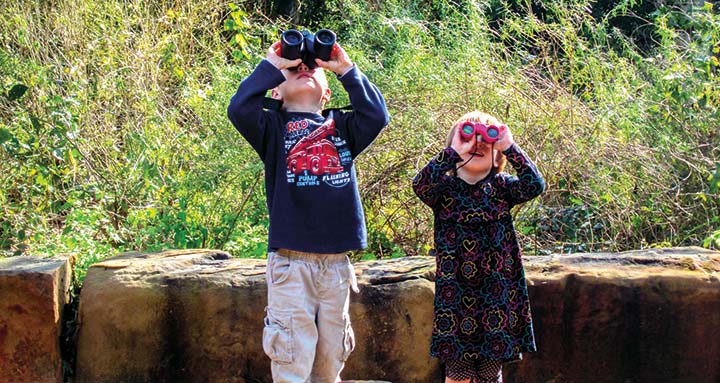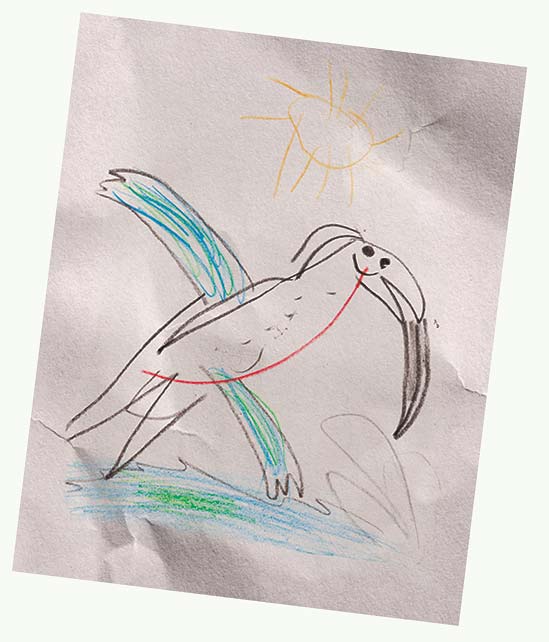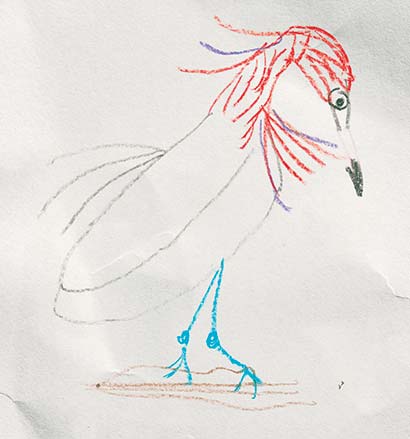 As soon as he sees the boardwalk, my four-year-old son Benjamin Byrd—“Byrdie” for short—takes off at a sprint, binoculars jiggling around his neck, while his sister Ana waddles behind him as fast as her two-year-old legs will carry her. “An ibis!” he shouts, already on the observation deck, having climbed a few fence rungs to take in the panoramic view of the pond.
As soon as he sees the boardwalk, my four-year-old son Benjamin Byrd—“Byrdie” for short—takes off at a sprint, binoculars jiggling around his neck, while his sister Ana waddles behind him as fast as her two-year-old legs will carry her. “An ibis!” he shouts, already on the observation deck, having climbed a few fence rungs to take in the panoramic view of the pond.
Estero Llano Grande State Park is at 154A Lakeview Drive in Weslaco, just off International Blvd. Call 956/565-3919.
Meanwhile, I scan the water’s surface, trying to see an ibis among the hundreds of waterfowl. Finally, there it is: the glossy wader with the unmistakable downward-curved bill.
Like many children on the autism spectrum, Byrdie is inclined toward highly specific interests. And ever since he pulled down an unused Birds of Texas guide from the bookshelf and asked me and my wife Laura to read it as a bedtime story, birds have been his greatest passion. By the time he was two-and-a-half, he could already identify 300 species, leading our family on an unexpected birding odyssey that has taken us from our home in the Rio Grande Valley to the north woods of Wisconsin. Of all of the places we’ve visited, though, our favorite family birding destination is still right here: Estero Llano Grande State Park.
 Cooped up in the house, Byrdie and Ana always seem to find ways to fight over one toy or another. But out here at the park, where the only sounds are ducks chattering and marsh canes rustling in the wind, the calm is contagious. I look ahead to the pond and there they are: Byrdie and Ana peering over the railing with their arms around each other’s waists—a sight almost as beautiful as the vista itself.
Cooped up in the house, Byrdie and Ana always seem to find ways to fight over one toy or another. But out here at the park, where the only sounds are ducks chattering and marsh canes rustling in the wind, the calm is contagious. I look ahead to the pond and there they are: Byrdie and Ana peering over the railing with their arms around each other’s waists—a sight almost as beautiful as the vista itself.
Estero Llano Grande is the geographic center of the World Birding Center, a network of Rio Grande Valley sites that preserves critical habitat for local and migratory birds. We check in at the park Visitor Center—its wood paneling and angular steel roof offering a modern, energy-efficient update on the old Civilian Conservation Corps principle of harmony with the surrounding environment—where Park Interpreter Lorena Guerra greets both kids by name. Then, we head off to the trail, traversing a thorn forest of mesquite and prickly pear cactus, Rio Grande woodlands, and shallow lakes. These pools, once agricultural fields and a dry lakebed, have been restored as the World Birding Center’s largest wetland area.
From the boardwalk running along the edge of Ibis Pond, Byrdie sights a chicken-like bird with an orange-and-red mask, like a feathered superhero. “Common gallinule!” he announces. Meanwhile, Ana points up at something yellow in a mesquite branch. “Kiskadee!” she proclaims, clearly proud of her precociousness. I’m always impressed by just how easy it is to navigate Estero Llano with kids. In a mile or less of walking, we see an astonishing diversity of habitats, and many of the birds are in plain sight—easy enough for a two-year-old to see.
In fact, a nocturnal pauraque—one of the rare “Valley specialties” that attracts birders from around the world—is sleeping right next to the trail, its feathers perfectly camouflaged against the underbrush. This must be how the group of birders in front of us, loaded down with expensive scopes and cameras, happens to miss them.
By the time we approach Alligator Pond, Ana is the one bounding ahead, and she’s not disappointed. A 10-foot American alligator sunbathes on the opposite bank. Byrdie, who has trained his binoculars on a night heron perched not three feet away from the gator, looks concerned. Luckily, I tell him, the birds are safe—an alligator resting in the sun is unlikely to move for anything. The same could be said for us, enjoying juice boxes and Goldfish crackers on the overlook, until at last I glance at my watch. It’s time to head home. I carry a tired Ana on my shoulders, while Byrdie runs on ahead, still on the lookout for one last bird.
Back at the Visitor Center, though, Ana catches a second wind. “Can we get an Explorer Pack?” she asks. Byrdie quickly seconds the motion. “Please,” they say, in unison. How can I say no?
 The attendant hands each kid a backpack stuffed with guidebooks, binoculars, and art supplies. Crayons in hand, they record our day’s sightings. While the kids draw, I page through an extra Explorer Pack sketchpad, admiring drawings from our previous visits, alongside those of other nature-loving kids who had also taken a few minutes to share their observations and memories.
The attendant hands each kid a backpack stuffed with guidebooks, binoculars, and art supplies. Crayons in hand, they record our day’s sightings. While the kids draw, I page through an extra Explorer Pack sketchpad, admiring drawings from our previous visits, alongside those of other nature-loving kids who had also taken a few minutes to share their observations and memories.
Looking at the drawings, I’m struck by the way our visits to Estero Llano Grande mark the passage of time in our family’s life: summer night hikes; the hayride and costume contest at the Spooky Science Fest (Byrdie was a great egret for Halloween); Christmas buñuelos and hot cocoa; and the spectacular spring migration, when birds from all over the hemisphere pause in Texas during their transcontinental journeys for much-needed rest. Similarly, Estero Llano Grande has become our family’s rest stop, a place to step away from the everyday challenges of raising two young kids and reflect on the lasting beauty of seasons past—and seasons to come.
At last, the sun edges toward the line of palms on the horizon. Before long, Mama will be wondering where we are. We pack up and head for the car, but on the way out, the park has one last surprise. Just ahead of us, a green jay flits from one side of the trail to the other,
in a dazzling streak of color. “Eenk, eenk, eenk!” it calls, as if bidding us goodbye. Or maybe it’s just saying, “See you next time!”








